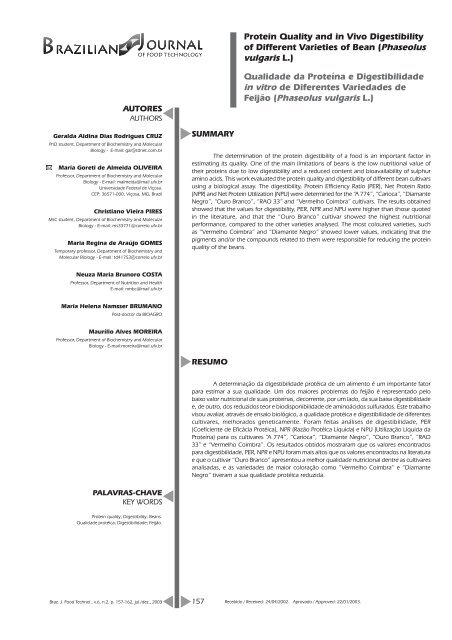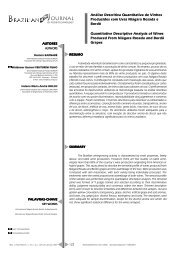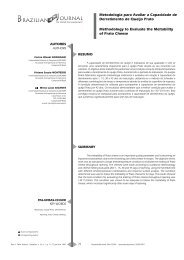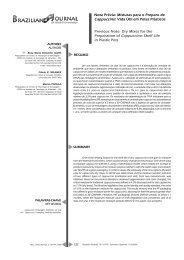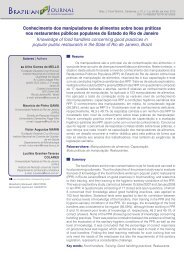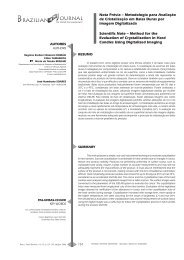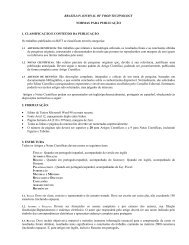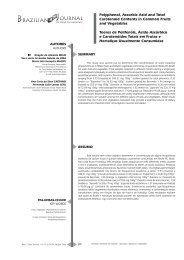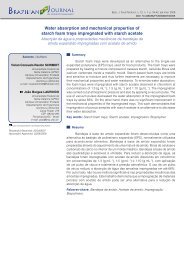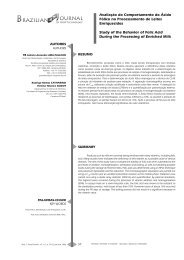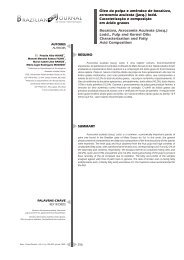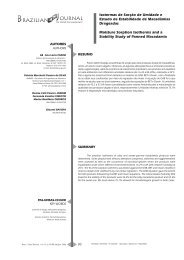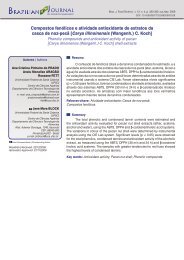Protein Quality and in Vivo Digestibility of Different Varieties of Bean ...
Protein Quality and in Vivo Digestibility of Different Varieties of Bean ...
Protein Quality and in Vivo Digestibility of Different Varieties of Bean ...
Create successful ePaper yourself
Turn your PDF publications into a flip-book with our unique Google optimized e-Paper software.
<strong>Prote<strong>in</strong></strong> <strong>Quality</strong> <strong>and</strong> <strong>in</strong> <strong>Vivo</strong> <strong>Digestibility</strong><br />
<strong>of</strong> <strong>Different</strong> <strong>Varieties</strong> <strong>of</strong> <strong>Bean</strong> (Phaseolus<br />
vulgaris L.)<br />
AUTORES<br />
AUTHORS<br />
Geralda Ald<strong>in</strong>a Dias Rodrigues CRUZ<br />
PhD student, Department <strong>of</strong> Biochemistry <strong>and</strong> Molecular<br />
Biology - E-mail: gal@tdnet.com.br<br />
Maria Goreti de Almeida OLIVEIRA<br />
Pr<strong>of</strong>essor, Department <strong>of</strong> Biochemistry <strong>and</strong> Molecular<br />
Biology - E-mail: malmeida@mail.ufv.br<br />
Universidade Federal de Viçosa.<br />
CEP: 36571-000, Viçosa, MG, Brazil<br />
Christiano Vieira PIRES<br />
MsC student, Department <strong>of</strong> Biochemistry <strong>and</strong> Molecular<br />
Biology - E-mail: ms33771@correio.ufv.br<br />
Maria Reg<strong>in</strong>a de Araújo GOMES<br />
Temporary pr<strong>of</strong>essor, Department <strong>of</strong> Biochemistry <strong>and</strong><br />
Molecular Biology - E-mail: td41753@correio.ufv.br<br />
SUMMARY<br />
Qualidade da Proteína e Digestibilidade<br />
<strong>in</strong> vitro de Diferentes Variedades de<br />
Feijão (Phaseolus vulgaris L.)<br />
The determ<strong>in</strong>ation <strong>of</strong> the prote<strong>in</strong> digestibility <strong>of</strong> a food is an important factor <strong>in</strong><br />
estimat<strong>in</strong>g its quality. One <strong>of</strong> the ma<strong>in</strong> limitations <strong>of</strong> beans is the low nutritional value <strong>of</strong><br />
their prote<strong>in</strong>s due to low digestibility <strong>and</strong> a reduced content <strong>and</strong> bioavailability <strong>of</strong> sulphur<br />
am<strong>in</strong>o acids. This work evaluated the prote<strong>in</strong> quality <strong>and</strong> digestibility <strong>of</strong> different bean cultivars<br />
us<strong>in</strong>g a biological assay. The digestibility, <strong>Prote<strong>in</strong></strong> Efficiency Ratio (PER), Net <strong>Prote<strong>in</strong></strong> Ratio<br />
(NPR) <strong>and</strong> Net <strong>Prote<strong>in</strong></strong> Utilization (NPU) were determ<strong>in</strong>ed for the “A 774”, “Carioca”, “Diamante<br />
Negro”, “Ouro Branco”, “RAO 33” <strong>and</strong> “Vermelho Coimbra” cultivars. The results obta<strong>in</strong>ed<br />
showed that the values for digestibility, PER, NPR <strong>and</strong> NPU were higher than those quoted<br />
<strong>in</strong> the literature, <strong>and</strong> that the “Ouro Branco” cultivar showed the highest nutritional<br />
performance, compared to the other varieties analysed. The most coloured varieties, such<br />
as “Vermelho Coimbra” <strong>and</strong> “Diamante Negro” showed lower values, <strong>in</strong>dicat<strong>in</strong>g that the<br />
pigments <strong>and</strong>/or the compounds related to them were responsible for reduc<strong>in</strong>g the prote<strong>in</strong><br />
quality <strong>of</strong> the beans.<br />
Neuza Maria Brunoro COSTA<br />
Pr<strong>of</strong>essor, Department <strong>of</strong> Nutrition <strong>and</strong> Health<br />
E-mail: nmbc@mail.ufv.br<br />
Maria Helena Namsser BRUMANO<br />
Post-doctor da BIOAGRO<br />
Maurílio Alves MOREIRA<br />
Pr<strong>of</strong>essor, Department <strong>of</strong> Biochemistry <strong>and</strong> Molecular<br />
Biology - E-mail:moreira@mail.ufv.br<br />
RESUMO<br />
A determ<strong>in</strong>ação da digestibilidade protéica de um alimento é um importante fator<br />
para estimar a sua qualidade. Um dos maiores problemas do feijão é representado pelo<br />
baixo valor nutricional de suas proteínas, decorrente, por um lado, da sua baixa digestibilidade<br />
e, de outro, dos reduzidos teor e biodisponibilidade de am<strong>in</strong>oácidos sulfurados. Este trabalho<br />
visou avaliar, através de ensaio biológico, a qualidade protéica e digestibilidade de diferentes<br />
cultivares, melhorados geneticamente. Foram feitas análises de digestibilidade, PER<br />
(Coeficiente de Eficácia Protéica), NPR (Razão Protéica Líquida) e NPU (Utilização Líquida da<br />
Proteína) para os cultivares “A 774”, “Carioca”, “Diamante Negro”, “Ouro Branco”, “RAO<br />
33” e “Vermelho Coimbra”. Os resultados obtidos mostraram que os valores encontrados<br />
para digestibilidade, PER, NPR e NPU foram mais altos que os valores encontrados na literatura<br />
e que o cultivar “Ouro Branco” apresentou a melhor qualidade nutricional dentre as cultivares<br />
analisadas, e as variedades de maior coloração como “Vermelho Coimbra” e “Diamante<br />
Negro” tiveram a sua qualidade protéica reduzida.<br />
PALAVRAS-CHAVE<br />
KEY WORDS<br />
<strong>Prote<strong>in</strong></strong> quality; <strong>Digestibility</strong>; <strong>Bean</strong>s.<br />
Qualidade protéica; Digestibilidade; Feijão.<br />
Braz. J. Food Technol., v.6, n.2, p. 157-162, jul./dez., 2003 157 Recebido / Received: 24/04/2002. Aprovado / Approved: 22/01/2003.
CRUZ, G.A.D.R. et al.<br />
<strong>Prote<strong>in</strong></strong> <strong>Quality</strong> <strong>and</strong> <strong>in</strong> <strong>Vivo</strong> <strong>Digestibility</strong><br />
<strong>of</strong> <strong>Different</strong> <strong>Varieties</strong> <strong>of</strong> <strong>Bean</strong> (Phaseolus<br />
vulgaris L.)<br />
1. INTRODUCTION<br />
The legume seeds are widely consumed around the<br />
world <strong>and</strong> the acceptability depends on the climatic conditions<br />
<strong>in</strong> the area. In Lat<strong>in</strong> America, beans (Phaseolus vulgaris) are the<br />
most consumed legume, supply<strong>in</strong>g considerable amounts <strong>of</strong><br />
nutrients to the diet <strong>of</strong> undernourished people (COELHO, 1991).<br />
BRESSANI et al. (1988) observed that besides <strong>in</strong>creas<strong>in</strong>g the<br />
prote<strong>in</strong> content <strong>of</strong> the meal, beans have contributed to<br />
improv<strong>in</strong>g the prote<strong>in</strong> quality <strong>of</strong> the diet by a factor <strong>of</strong> about 50<br />
to 70%, when constituted predom<strong>in</strong>antly <strong>of</strong> legumes <strong>and</strong> cereals,<br />
because bean prote<strong>in</strong>s are rich <strong>in</strong> lys<strong>in</strong>e, complement<strong>in</strong>g prote<strong>in</strong>s<br />
from cereals such as rice or corn, well known for be<strong>in</strong>g deficient<br />
<strong>in</strong> this am<strong>in</strong>o acid. This fact means beans are <strong>of</strong> exceptional<br />
nutritional importance, especially when the restricted <strong>in</strong>gestion<br />
<strong>of</strong> food <strong>of</strong> animal orig<strong>in</strong> among the low <strong>in</strong>come population is<br />
considered, to whom the legume is a daily food.<br />
Rice <strong>and</strong> beans are the staple foods <strong>of</strong> the Brazilian diet<br />
<strong>and</strong> mixed <strong>in</strong> adequate proportion, they may improve the<br />
biological value <strong>of</strong> the prote<strong>in</strong>s consumed (VIEIRA, 1992).<br />
The genus Phaseolus <strong>in</strong>cludes all species known as<br />
beans. The species Phaseolus vulgaris L. is the most common<br />
<strong>and</strong> <strong>in</strong>cludes many varieties such as “Carioca”, “Roxo” (Purple),<br />
“Mulat<strong>in</strong>ho” (Brown), “Preto” (Black) <strong>and</strong> others (KANAMORI<br />
et al., 1982).<br />
Although represent<strong>in</strong>g an important source <strong>of</strong> prote<strong>in</strong>s,<br />
starch, vitam<strong>in</strong>s, m<strong>in</strong>erals <strong>and</strong> fiber (COELHO, 1991; GEIL;<br />
ANDERSON, 1994; BARAMPANA; SIMARD, 1994; MARTINEZ<br />
et al., 1998) bean nutrients are not readily available for use by<br />
the organism (EVANS; BAUER, 1978; SARWAR; PEACE, 1986;<br />
RODRIGUES, 1995; CARBONARO et al., 1997).<br />
<strong>Digestibility</strong> is the first factor affect<strong>in</strong>g the efficiency <strong>of</strong><br />
diet prote<strong>in</strong>s. When certa<strong>in</strong> peptide l<strong>in</strong>ks are not hydrolysed <strong>in</strong><br />
the digestive process, part <strong>of</strong> the prote<strong>in</strong> is either excreted <strong>in</strong><br />
the faeces, or transformed <strong>in</strong>to a metabolic product by<br />
microorganisms present <strong>in</strong> the large <strong>in</strong>test<strong>in</strong>e (SGARBIERI;<br />
WHITAKER, 1982). One <strong>of</strong> the major limitations <strong>of</strong> beans is the<br />
low nutritional value <strong>of</strong> their prote<strong>in</strong>s, due to their poor<br />
digestibility <strong>and</strong> reduced content <strong>of</strong> sulphur am<strong>in</strong>o acids<br />
(NIELSON, 1991; BRESSANI, 1993; GENOVESE; LAJOLO, 1996,<br />
1998). Besides reduced sulphur am<strong>in</strong>o acid contents, they also<br />
show reduced bioavailability (SGARBIERI; WHITAKER, 1982).<br />
The low biological usage <strong>of</strong> bean prote<strong>in</strong>s is attributed<br />
to many factors such as: compact structure <strong>of</strong> the native<br />
prote<strong>in</strong>s which may resist proteolysis; anti-nutritional<br />
compounds which can modify the digestibility, alter<strong>in</strong>g the<br />
liberation <strong>of</strong> am<strong>in</strong>o acids <strong>and</strong> high excretion <strong>of</strong> endogenous<br />
nitrogen (WU; KUNKEL, 1995).<br />
In general, the digestibility <strong>of</strong> bean prote<strong>in</strong>s can be<br />
improved by thermal treatment (WU et al., 1974). However,<br />
studies <strong>in</strong>dicate that the digestibility is limited, even after<br />
thermal treatment, due to the primary conformation <strong>of</strong> the<br />
prote<strong>in</strong>s <strong>and</strong>/or to the presence <strong>of</strong> some components <strong>of</strong> the<br />
seed, such as thermo-stable protease <strong>in</strong>hibitors <strong>and</strong><br />
polyphenols which complex with digestive enzymes <strong>and</strong>/or<br />
with bean prote<strong>in</strong>s, reduc<strong>in</strong>g their susceptibility to hydrolysis<br />
(RODRIGUES; LAJOLO, 1993).<br />
An improvement <strong>of</strong> digestibility does not necessary<br />
imply an <strong>in</strong>crease <strong>in</strong> prote<strong>in</strong> quality, such that the am<strong>in</strong>o acids<br />
can be better absorbed, but not take part <strong>in</strong> prote<strong>in</strong> synthesis,<br />
due to the deficiency <strong>of</strong> some essential am<strong>in</strong>o acids. The<br />
nutritional value <strong>of</strong> a food is <strong>in</strong>dicated by its chemical<br />
composition, although this does not characterize the food from<br />
the nutritional po<strong>in</strong>t <strong>of</strong> view. Food nutrients are available to<br />
the organism <strong>in</strong> their totality, only after their <strong>in</strong>gestion<br />
(SGARBIERI, 1989). Hence, biological analyses such as PER, NPR<br />
<strong>and</strong> NPU, which evaluate the prote<strong>in</strong> quality based on the<br />
organism’s response to the prote<strong>in</strong> <strong>in</strong>gestion, are important<br />
tools for better food characterization.<br />
Several varieties <strong>of</strong> bean with great agricultural potential<br />
have been obta<strong>in</strong>ed from genetic breed<strong>in</strong>g studies. Among<br />
these varieties are some that st<strong>and</strong> out due to the presence <strong>of</strong><br />
more favourable characteristics, <strong>and</strong> thus deserve more attention<br />
for nutritional studies. Thus, the purpose <strong>of</strong> the present study<br />
was to evaluate the prote<strong>in</strong> quality <strong>of</strong> the cultivars, A774, Carioca,<br />
Diamante Negro, Ouro Branco, RAO 33 <strong>and</strong> Vermelho Coimbra.<br />
These cultivars were k<strong>in</strong>dly supplied by the Centro Nacional de<br />
Pesquisa de Arroz e Feijão da Empresa Brasileira de Pesquisa<br />
Agropecuária (EMBRAPA – CNPAF).<br />
2. MATERIALS AND METHODS<br />
2.1 Genetic material<br />
The bean samples (Phaseolus vulgaris L.) <strong>of</strong> the varieties<br />
“A774” (brown group), “Carioca” (Carioca group), “Diamante<br />
Negro” (black group), “Ouro Branco” (white group), “RAO”<br />
33 (purple group) <strong>and</strong> “Vermelho Coimbra” (red group) were<br />
obta<strong>in</strong>ed from the Empresa Brasileira de Pesquisa Agropecuária<br />
(EMBRAPA/CNPAF), Goiânia, GO, Brazil.<br />
2.2 Preparation <strong>of</strong> bean flour<br />
For the preparation <strong>of</strong> whole cooked flour, the gra<strong>in</strong>s<br />
were cleaned <strong>and</strong> cooked <strong>in</strong> water <strong>in</strong> the proportion <strong>of</strong> 1:1.5<br />
(w/v) <strong>in</strong> a pressure cooker for forty m<strong>in</strong>utes. The gra<strong>in</strong>s were<br />
then dried <strong>in</strong> an air circulat<strong>in</strong>g oven (24 h / 60 o C) <strong>and</strong> ground<br />
<strong>in</strong> a mill.<br />
2.3 Preparation <strong>of</strong> the diets<br />
The composition <strong>of</strong> the experimental diets is shown <strong>in</strong><br />
Table 1. Diets 1 to 6 were prepared by us<strong>in</strong>g bean samples as<br />
prote<strong>in</strong> sources. Diet 7 (case<strong>in</strong>) was the st<strong>and</strong>ard <strong>and</strong> diet 8<br />
was the prote<strong>in</strong> free diet.<br />
The nitrogen content <strong>of</strong> the mixture was determ<strong>in</strong>ed<br />
by the semi-micro Kjeldahl method us<strong>in</strong>g the factor 6.25 to<br />
obta<strong>in</strong> the prote<strong>in</strong> content (AOAC, 1984).<br />
Braz. J. Food Technol., v.6, n.2, p.157-162, jul./dez., 2003 158
CRUZ, G.A.D.R. et al.<br />
<strong>Prote<strong>in</strong></strong> <strong>Quality</strong> <strong>and</strong> <strong>in</strong> <strong>Vivo</strong> <strong>Digestibility</strong><br />
<strong>of</strong> <strong>Different</strong> <strong>Varieties</strong> <strong>of</strong> <strong>Bean</strong> (Phaseolus<br />
vulgaris L.)<br />
TABLE 1. Composition <strong>of</strong> the diets used <strong>in</strong> the experiments with rats (g/100g <strong>of</strong> the mixture).<br />
Ingredients<br />
D1<br />
D2<br />
D3<br />
D4<br />
D5<br />
D6<br />
D7<br />
D8<br />
1<br />
Whole<br />
<strong>and</strong> cooked Ouro Branco flour<br />
50.82<br />
- - - - - - -<br />
1<br />
Whole<br />
<strong>and</strong> cooked Carioca flour<br />
- 55.49<br />
- - - - - -<br />
1<br />
Whole<br />
<strong>and</strong> cooked RAO 33 flour<br />
- - 52.14<br />
- - - - -<br />
Whole<br />
<strong>and</strong> cooked A 774 flour1 - - - 46.00<br />
- - - -<br />
1<br />
Whole<br />
<strong>and</strong> cooked Verm. Coimbra flour<br />
- - - - 43.49<br />
- - -<br />
1<br />
Whole<br />
<strong>and</strong> cooked Diamante Negro flour - - - - - 42.29<br />
- -<br />
Case<strong>in</strong>2 - - - - - - 12.30<br />
-<br />
2,<br />
*<br />
M . 5<br />
<strong>in</strong>eral mix<br />
3 3.<br />
5 3.<br />
5 3.<br />
5 3.<br />
5 3.<br />
5 3.<br />
5 3. 5<br />
Vitam<strong>in</strong><br />
mix2 1.<br />
0 1.<br />
0 1.<br />
0 1.<br />
0 1.<br />
0 1.<br />
0 1.<br />
0 1. 0<br />
3<br />
Soybean<br />
oil<br />
7.<br />
0 7.<br />
0 7.<br />
0 7.<br />
0 7.<br />
0 7.<br />
0 7.<br />
0 7. 0<br />
2<br />
Chol<strong>in</strong>e<br />
bitartrate<br />
0.25<br />
0.25<br />
0.25<br />
0.25<br />
0.25<br />
0.25<br />
0.25<br />
0.25<br />
Cornstarch<br />
(q.s.p)<br />
3<br />
8.93<br />
4.26<br />
7.61<br />
13.75<br />
16.25<br />
17.46<br />
42.45<br />
54.75<br />
L-cyst<strong>in</strong>e<br />
2<br />
0.<br />
3 0.<br />
3 0.<br />
3 0.<br />
3 0.<br />
3 0.<br />
3 0.<br />
3 0. 3<br />
2<br />
Fibre<br />
- - - - - - 5.<br />
0 5. 0<br />
Dextr<strong>in</strong>ised<br />
cornstarch2 13.<br />
2 13.<br />
2 13.<br />
2 13.<br />
2 13.<br />
2 13.<br />
2 13.<br />
2 13. 2<br />
Sucrose3 15.<br />
0 15.<br />
0 15.<br />
0 15.<br />
0 15.<br />
0 15.<br />
0 15.<br />
0 15. 0<br />
<strong>Prote<strong>in</strong></strong>s<br />
(%)<br />
9.96<br />
9.68<br />
9.66<br />
9.33<br />
9.99<br />
9.54<br />
9.25<br />
-<br />
1 Flour produced from the bean samples analysed 2 Obta<strong>in</strong>ed from RHOSTER- Industry <strong>and</strong> commercial Ltda<br />
3 Accord<strong>in</strong>g to REEVES et al. (1993) 4 Obta<strong>in</strong>ed from a local supermarket <strong>in</strong> Viçosa<br />
2.4 Biological assay<br />
The evaluation <strong>of</strong> the prote<strong>in</strong> quality <strong>of</strong> the experimental<br />
diets was performed by a biological assay. 48 male recently<br />
weaned Wistar rats, weigh<strong>in</strong>g 50 to 60g, from the Department<br />
<strong>of</strong> Nutrition <strong>and</strong> Health, Universidade Federal de Viçosa, Brazil,<br />
were used. The animals were divided <strong>in</strong>to eight groups with<br />
six animals each, so that the weight difference between the<br />
groups did not exceed 5g. The rats were placed <strong>in</strong> <strong>in</strong>dividual<br />
cages <strong>and</strong> received water <strong>and</strong> their experimental diets ad<br />
libitum for 14 days (AOAC, 1975). The animals were ma<strong>in</strong>ta<strong>in</strong>ed<br />
at 22 ± 3 o C <strong>and</strong> the consumption <strong>of</strong> food was monitored<br />
weekly.<br />
The true digestibility (AOAC, 1984) was determ<strong>in</strong>ed by<br />
measur<strong>in</strong>g the amount <strong>of</strong> nitrogen <strong>in</strong>gested <strong>in</strong> the diet, the<br />
amount elim<strong>in</strong>ated <strong>in</strong> the faeces, <strong>and</strong> the metabolic loss <strong>in</strong> the<br />
faeces, which corresponds to the faecal nitrogen <strong>in</strong> the prote<strong>in</strong><br />
free group.<br />
For the digestibility determ<strong>in</strong>ation, the diets were<br />
labelled with <strong>in</strong>digocarm<strong>in</strong> <strong>in</strong> the proportion <strong>of</strong> 100mg/100g,<br />
<strong>and</strong> given to the animals on the 7th <strong>and</strong> 13th days. The faeces<br />
were collected from the 8th to the 13th days <strong>in</strong> <strong>in</strong>dividual<br />
conta<strong>in</strong>ers for each animal <strong>and</strong> ma<strong>in</strong>ta<strong>in</strong>ed under refrigeration.<br />
At the end <strong>of</strong> the experiment, the faeces were dried <strong>in</strong><br />
an air circulat<strong>in</strong>g oven at 105 o C for 24h, cooled, weighed <strong>and</strong><br />
ground <strong>in</strong> a food processor for the determ<strong>in</strong>ation <strong>of</strong> nitrogen<br />
concentration by the semi-micro Kjeldahl method (AOAC,<br />
1984). The samples were analysed <strong>in</strong> triplicate (AOAC, 1984).<br />
The <strong>Prote<strong>in</strong></strong> Efficiency Ratio (PER) was determ<strong>in</strong>ed from<br />
the ratio <strong>of</strong> weight ga<strong>in</strong> <strong>of</strong> the animals <strong>and</strong> the consumption<br />
<strong>of</strong> prote<strong>in</strong> (AOAC, 1975).<br />
The Net <strong>Prote<strong>in</strong></strong> Ratio (NPR) was determ<strong>in</strong>ed by divid<strong>in</strong>g<br />
the weight ga<strong>in</strong> <strong>of</strong> the test group plus the weight loss <strong>of</strong> the<br />
prote<strong>in</strong> free group by the consumption <strong>of</strong> prote<strong>in</strong> <strong>of</strong> the test<br />
group (BENDER; DOELL, 1957).<br />
The Net <strong>Prote<strong>in</strong></strong> Utilization (NPU) was determ<strong>in</strong>ed by<br />
the nitrogen retention <strong>of</strong> the carcass <strong>of</strong> the animals. For the<br />
calculation <strong>of</strong> NPU, the animals were sacrificed by <strong>in</strong>hal<strong>in</strong>g CO 2<br />
at the end <strong>of</strong> the experiment. The carcasses were dried <strong>in</strong> an<br />
air circulat<strong>in</strong>g oven at 105 o C for 24h, cooled <strong>and</strong> weighed.<br />
Fat was extracted <strong>in</strong> a Soxhlet apparatus for 4h us<strong>in</strong>g petroleum<br />
ether as solvent. The nitrogen content <strong>of</strong> the carcasses was<br />
determ<strong>in</strong>ed by the semi-micro Kjeldahl method. The samples<br />
were analysed <strong>in</strong> triplicate (AOAC, 1984).<br />
The NPU was calculated accord<strong>in</strong>g to the formula<br />
(HEGSTED, 1977):<br />
Nt Na 100<br />
NPU <br />
Ni<br />
Nt = body nitrogen <strong>of</strong> test group<br />
Na = body nitrogen <strong>of</strong> the free prote<strong>in</strong> group<br />
Ni = nitrogen <strong>in</strong>take <strong>of</strong> the test group<br />
The results obta<strong>in</strong>ed were submitted to an analysis <strong>of</strong><br />
variance <strong>and</strong> the mean values compared by Tukey’s test at 5%<br />
<strong>of</strong> probability.<br />
Braz. J. Food Technol., v.6, n.2, p. 157-162, jul./dez., 2003 159
CRUZ, G.A.D.R. et al.<br />
<strong>Prote<strong>in</strong></strong> <strong>Quality</strong> <strong>and</strong> <strong>in</strong> <strong>Vivo</strong> <strong>Digestibility</strong><br />
<strong>of</strong> <strong>Different</strong> <strong>Varieties</strong> <strong>of</strong> <strong>Bean</strong> (Phaseolus<br />
vulgaris L.)<br />
3.1 <strong>Digestibility</strong><br />
3. RESULTS AND DISCUSSION<br />
The results for true digestibility are summarised <strong>in</strong><br />
Table 2.<br />
It was observed that the true digestibility obta<strong>in</strong>ed from<br />
the varieties analysed ranged from 85.66% for “RAO 33” to<br />
93.97% for “Ouro Branco”.<br />
Polyphenols, one <strong>of</strong> the pigments responsible for the<br />
different colours <strong>of</strong> legumes, have been studied with the<br />
purpose <strong>of</strong> evaluat<strong>in</strong>g their significance accord<strong>in</strong>g to the<br />
nutritional as well as the technological po<strong>in</strong>ts <strong>of</strong> view (ELIAS,<br />
1982). Their ability to form complexes <strong>and</strong> to precipitate<br />
prote<strong>in</strong>s makes them important from the nutritional po<strong>in</strong>t <strong>of</strong><br />
view. JAFFÉ (1950), quoted by SGARBIERI, WHITAKER (1982),<br />
reported values <strong>of</strong> 76.8; 79.5 & 84.1% for <strong>in</strong> vivo digestibility<br />
<strong>of</strong> prote<strong>in</strong>s from black, p<strong>in</strong>k <strong>and</strong> white beans (Phaseolus<br />
vulgaris), respectively.<br />
JAFFÉ; FLORES (1975) found <strong>in</strong> vivo <strong>and</strong> <strong>in</strong> vitro<br />
digestibility values <strong>of</strong> 68.9 <strong>and</strong> 70.1%, respectively, for cooked<br />
black beans.<br />
Compar<strong>in</strong>g the results obta<strong>in</strong>ed for the varieties<br />
analysed with those <strong>of</strong> case<strong>in</strong> (Table 2), it was observed that<br />
case<strong>in</strong> digestibility was significantly higher than that <strong>of</strong> the<br />
varieties studied, except for the “Ouro Branco” cultivar, which<br />
was not statistically different from case<strong>in</strong>. HUGHES et al. (1996)<br />
found 80.9% digestibility for white beans, which was much<br />
lower than the value obta<strong>in</strong>ed for the “Ouro Branco” variety.<br />
TABLE 2. True digestibility (TD) <strong>of</strong> the case<strong>in</strong> diet <strong>and</strong> <strong>of</strong> the<br />
whole cooked bean varieties <strong>in</strong> the experiment with rats.<br />
Diet<br />
G roup<br />
DV (%)*<br />
Case<strong>in</strong><br />
(D7)<br />
- 9.00<br />
Ouro<br />
Branco (D1)<br />
Diamante<br />
Negro (D6)<br />
Vermelho<br />
Coimbra (D5)<br />
A 774 (D4)<br />
Carioca<br />
(D2)<br />
RAO 33 (D3)<br />
9<br />
a<br />
White<br />
3.97<br />
9<br />
a. b<br />
Black<br />
1.50<br />
9<br />
b. c<br />
Red<br />
0.44<br />
9<br />
b.c. d<br />
Brown<br />
8.67<br />
8<br />
b.c. d<br />
Carioca<br />
8.05<br />
8<br />
c. d<br />
Purple<br />
5.66<br />
8<br />
d<br />
* Means with<strong>in</strong> the same column followed by the same letter, are not<br />
statistically different, accord<strong>in</strong>g to Tukey test at 5% <strong>of</strong> probability.<br />
BRESSANI (1989), <strong>in</strong> a review, showed that cooked<br />
white beans were more digestible than the coloured cooked<br />
beans, similar to the results found <strong>in</strong> the present study.<br />
In general, the values for true digestibility observed here<br />
were higher than those found <strong>in</strong> the literature for other varieties<br />
<strong>and</strong> these results can be attributed to many factors such as :<br />
low concentration <strong>of</strong> anti-nutritional compounds present <strong>in</strong><br />
the gra<strong>in</strong> (NIELSON, 1991), different varieties analysed, sow<strong>in</strong>g<br />
conditions, storage time <strong>and</strong> heat treatments, which may have<br />
produced, physicochemical changes <strong>in</strong> the prote<strong>in</strong>s <strong>of</strong> the<br />
legume seed, affect<strong>in</strong>g their f<strong>in</strong>al nutritional properties<br />
(ALONSO et al., 2000). These factors may have contributed to<br />
<strong>in</strong>crease the digestibility <strong>of</strong> these cultivars.<br />
The improvement <strong>of</strong> digestibility is not necessarily<br />
related to an <strong>in</strong>crease <strong>in</strong> prote<strong>in</strong> quality, particularly when the<br />
prote<strong>in</strong> is deicient <strong>in</strong> essential am<strong>in</strong>o acids. For this reason,<br />
biological assays such as PER, NPR <strong>and</strong> NPU were performed,<br />
<strong>in</strong> order to evaluate the prote<strong>in</strong> quality, based on the organism’s<br />
response to the prote<strong>in</strong> <strong>in</strong>take.<br />
3.2 PER, NPR <strong>and</strong> NPU<br />
The results for PER <strong>and</strong> RPER (relative PER); NPR <strong>and</strong><br />
RNPR (relative NPR); NPU <strong>and</strong> RNPU (relative NPU) <strong>of</strong> the<br />
experiment are summarised <strong>in</strong> Table 3.<br />
The values for PER <strong>and</strong> RPER ranged from 1.2 to 2.36<br />
<strong>and</strong> from 30.92% to 60.82%, respectively, <strong>and</strong> were statistically<br />
different (P < 0.05) from the values obta<strong>in</strong>ed for case<strong>in</strong>.<br />
Among the bean samples analysed, the “Ouro Branco”<br />
variety showed the highest nutritional value based on its PER<br />
<strong>and</strong> RPER values, which were significantly higher than the other<br />
varieties. The “Diamante Negro” showed the lowest PER <strong>and</strong><br />
RPER values. These results are similar to those obta<strong>in</strong>ed by<br />
BRESSANI; ELIAS (1984), where white beans showed better<br />
nutritional performance than purple, black or brown beans.<br />
In the present work, significant differences <strong>in</strong> RPER were<br />
observed among beans <strong>and</strong> between the bean varieties <strong>and</strong><br />
case<strong>in</strong> diets.<br />
TABLE 3. PER, RPER (relative PER), NPR, RNPR (relative NPR),<br />
NPU, RNPU (relative NPU) <strong>of</strong> case<strong>in</strong> <strong>and</strong> whole cooked bean<br />
diets.<br />
DIET<br />
G ROUP<br />
P ER*<br />
RPER<br />
(%)<br />
N PR<br />
RNPR(%<br />
)<br />
N PU<br />
RNPU%<br />
Case<strong>in</strong><br />
(D7) - 3.88a 100a 4.56a 100a 66.73a 100a<br />
Ouro Branco<br />
(D1)<br />
Carioca<br />
(D2)<br />
A 774 (D4)<br />
RAO 33 (D3)<br />
White<br />
2.36b 60.82b 3.49b 76.53b 52.11a . b 78.09a.<br />
b<br />
b.<br />
c<br />
b.<br />
c<br />
b b a.<br />
b a. b<br />
Carioca<br />
2.18<br />
56.18<br />
3.49<br />
76.53<br />
54.27<br />
81.32<br />
Brown<br />
1.56b .c.d. e 40.20b .c.d. e 2.89b .c. d 63.37b .c. d 47.66b 71.42b<br />
c.d.<br />
e<br />
c.d.<br />
e<br />
c.<br />
d<br />
c.<br />
d<br />
b b<br />
Purple<br />
1.44<br />
37.11<br />
2.76<br />
60.52<br />
46.38<br />
69.50<br />
Vermelho<br />
Coimbra (D5)<br />
Red<br />
1.32d . e 34.00d . e 2.57d 56.35d 42.61b 63.85b<br />
Diamante<br />
Negro (D6)<br />
Black<br />
1.<br />
2 e 30.92<br />
d 2.53<br />
d 55.48<br />
b 49.61<br />
b 74.34<br />
Means with<strong>in</strong> the same column followed by the same letter, are not<br />
statistically different, accord<strong>in</strong>g to Tukey’s test at 5% <strong>of</strong> probability.<br />
PER <strong>and</strong> RPER were determ<strong>in</strong>ed on the 14o day <strong>of</strong> the experiment.<br />
The NPR <strong>and</strong> RNPR <strong>of</strong> the bean varieties were<br />
significantly lower than for case<strong>in</strong> <strong>and</strong> ranged from 2.53 to<br />
3.49 <strong>and</strong> 55.48% to 76.53%, respectively (Table 3), <strong>in</strong>dicat<strong>in</strong>g<br />
that statistically significant differences were detected only for<br />
case<strong>in</strong>. This is expla<strong>in</strong>ed by the fact that PER does not consider<br />
the use <strong>of</strong> the prote<strong>in</strong> for ma<strong>in</strong>tenance, only for growth<br />
promotion, tend<strong>in</strong>g to underestimate the quality <strong>of</strong> <strong>in</strong>ferior<br />
prote<strong>in</strong>s <strong>and</strong>, for this reason, enhances exist<strong>in</strong>g differences<br />
Braz. J. Food Technol., v.6, n.2, p.157-162, jul./dez., 2003 160
CRUZ, G.A.D.R. et al.<br />
<strong>Prote<strong>in</strong></strong> <strong>Quality</strong> <strong>and</strong> <strong>in</strong> <strong>Vivo</strong> <strong>Digestibility</strong><br />
<strong>of</strong> <strong>Different</strong> <strong>Varieties</strong> <strong>of</strong> <strong>Bean</strong> (Phaseolus<br />
vulgaris L.)<br />
among prote<strong>in</strong>s <strong>of</strong> higher <strong>and</strong> smaller nutritional values,<br />
contrary to the NPR value (SGARBIERI, 1989).<br />
The “Ouro Branco”, “Carioca” <strong>and</strong> “A 774” varieties<br />
showed the highest values for NPR. Although the “Diamante<br />
Negro” variety showed the lowest value for NPR <strong>in</strong> the present<br />
study, this value was higher than those observed by other<br />
authors work<strong>in</strong>g with black beans (BRESSANI et al.,1981;<br />
DURIGAN et al., 1987; CHIARADIA 1997).<br />
The higher values for NPR <strong>and</strong> RNPR compared to those<br />
found <strong>in</strong> the literature may be due to a decrease <strong>in</strong> ant<strong>in</strong>utritional<br />
factors dur<strong>in</strong>g the heat treatment process or to<br />
differences amongst varieties. Several studies confirm that heat<br />
treatment can be efficient <strong>in</strong> reduc<strong>in</strong>g tryps<strong>in</strong> <strong>in</strong>hibitor activity<br />
(KAKADE; EVANS, 1966; ANTUNES; SGARBIERI, 1980; MENDEZ<br />
et al., 1993), although it may not be responsible for the reduced<br />
prote<strong>in</strong> digestibility <strong>in</strong> cooked beans.<br />
The results for NPU <strong>and</strong> RNPU ranged from 49.61 to<br />
52.11 <strong>and</strong> from 74.34% to 78.09%, respectively. The “Carioca”<br />
<strong>and</strong> “Ouro Branco” varieties were statistically equal to case<strong>in</strong>.<br />
The “Ouro Branco” variety showed the highest prote<strong>in</strong><br />
quality, based on its digestibility, PER, NPR <strong>and</strong> NPU values.<br />
No significant difference was observed between the NPU <strong>of</strong><br />
this variety <strong>and</strong> the case<strong>in</strong> diet. The most coloured varieties,<br />
such as “Vermelho Coimbra” <strong>and</strong> “Diamante Negro” showed<br />
lower values, <strong>in</strong>dicat<strong>in</strong>g that the pigments <strong>and</strong>/or the<br />
compounds related to them, were responsible for reduc<strong>in</strong>g<br />
the prote<strong>in</strong> quality <strong>of</strong> the beans.<br />
ACKNOWLEGMENT<br />
The authors thank FAPEMIG for the f<strong>in</strong>ancial support.<br />
REFERENCES<br />
ALONSO, R.; AGUIRRE, A.; MARZO, F. Effects <strong>of</strong> extrusion <strong>and</strong><br />
traditional process<strong>in</strong>g methods on ant<strong>in</strong>utrients <strong>and</strong> <strong>in</strong> vitro<br />
digestibility <strong>of</strong> prote<strong>in</strong> <strong>and</strong> starch <strong>in</strong> faba <strong>and</strong> kidney beans. Food<br />
Chemistry, v.68, p.159-165, 2000.<br />
ANTUNES, P. L.; SGARBIERI, V. C. Effect <strong>of</strong> heat treatment on the toxicity<br />
<strong>and</strong> nutritive value <strong>of</strong> dry bean (Phaseolus vulgaris, var. ros<strong>in</strong>ha<br />
G2) prote<strong>in</strong>. J. Agric. Food Chem., v.28, n.5, p.9535-9380, 1980.<br />
ASSOCIATION OF OFFICIAL ANALYTICAL CHEMISTS – AOAC. Official<br />
methods <strong>of</strong> analysis <strong>of</strong> the Association <strong>of</strong> Official Analytical<br />
Chemists. 14. ed. Arl<strong>in</strong>gton: 1984. 1141p.<br />
ASSOCIATION OF OFFICIAL ANALYTICAL CHEMISTS – AOAC. Official<br />
methods <strong>of</strong> analysis <strong>of</strong> the Association <strong>of</strong> Official Analytical<br />
Chemists. Wash<strong>in</strong>gton: 1975. 1094 p.<br />
BARAMPANA, Z.; SIMARD, R. E.Oligosaccharides, ant<strong>in</strong>utritional factors<br />
<strong>and</strong> prote<strong>in</strong> digestibility <strong>of</strong> dry beans as affected by process<strong>in</strong>g.<br />
Journal <strong>of</strong> Food Science, v.59, n.4, p.833-838, 1994.<br />
BENDER, A.E.; DOELL, B.H. Note on the determ<strong>in</strong>ation <strong>of</strong> net prote<strong>in</strong><br />
utilization by carcass analysis. Britsch Journal <strong>of</strong> Nutrition, v.11,<br />
p.138-143, 1957.<br />
BLANCO, A.; BRESSANI, R. Biodisponibilidad de am<strong>in</strong>oacidos en el<br />
frijol (Phaseolus vulgaris). Archivos Lat<strong>in</strong>oamericanos de<br />
Nutrición, v.41, n.1, p.38-51, 1991.<br />
BRESSANI, R. Gra<strong>in</strong> quality <strong>of</strong> common beans. Food Reviews<br />
International, v.9, p.237-297, 1993.<br />
BRESSANI, R.; ELIAS, L. G.; ESPAÑA, M. E. Posibles relaciones entre<br />
medidas fisicas, quimicas y nutricionales en frijol comum (Phaseolus<br />
vulgaris). Archivos Lat<strong>in</strong>oamericanos de Nutrición, v.31, n.3,<br />
p.550-570, 1981.<br />
BRESSANI, R.; ELIAS, L. G. Relacion entre la digestibiIidad y el valor<br />
prote<strong>in</strong>ico del frijol comum (Phaseolus vulgaris). ). Archivos<br />
Lat<strong>in</strong>oamericanos de Nutrición, v.34, n.1, p.189-197, 1984.<br />
BRESSANI, R.; NAVARRETE, D. A.; GARCIA-SOTO, A. et al. Cul<strong>in</strong>ary<br />
pratices <strong>and</strong> consumption characteristics <strong>of</strong> common beans at the<br />
rural home level. Archivos Lat<strong>in</strong>oamericanos de Nutrición,<br />
v.38, p.925-934, 1988.<br />
BRESSANI, R. Revision sobre la calidad del grano de frijol. Archivos<br />
Lat<strong>in</strong>oamericanos de Nutrición, v.39, n.3, p.419-443, 1989.<br />
CARBONARO, M.; CAPPELONI, M.; NICOLI, S.; LUCARINI, M.;<br />
CARNOVALE, E. Solubility-digestibility relationship <strong>of</strong> legume<br />
prote<strong>in</strong>s. Journal <strong>of</strong> Agricultural <strong>and</strong> Food Chemistry, v.45,<br />
p.3387-3394, 1997.<br />
CHIARADIA, A.C.N. Determ<strong>in</strong>ação da estrutura de pigmentos<br />
de feijão e estudo da sua ação na qualidade protéica.<br />
Viçosa, MG: UFV, 1997. 107p. Tese (Doutorado em Ciência e<br />
Tecnologia de Alimentos) – Universidade Federal de Viçosa, 1997.<br />
COELHO, R. C. Considerações sobre as proteínas do feijão. Revista<br />
de Nutrição, v.4, n.1, p.122-145, 1991.<br />
DURIGAN, J. F.; SGARBIERI, V.C.; BULISANI, E. A. <strong>Prote<strong>in</strong></strong> value <strong>of</strong> dry<br />
bean cultivars: factors <strong>in</strong>terfer<strong>in</strong>g with biological utilization.<br />
Journal <strong>of</strong> Agricultural <strong>and</strong> Food Chemistry, v.2, n.35, p.694-<br />
698, 1987.<br />
ELIAS, L. G. Conocimientos actuales sobre el proceso de<br />
endurecimiento Del frijol. ). Archivos Lat<strong>in</strong>oamericanos de<br />
Nutrición, v.32, n.2, p.233-257, 1982.<br />
EVANS, R. J.; BAUER, D. H. Studies <strong>of</strong> the poor utilization <strong>of</strong> the rat <strong>of</strong><br />
methion<strong>in</strong>e <strong>and</strong> cyst<strong>in</strong>e <strong>in</strong> heated dry bean seed (Phaseolus<br />
vulgaris). Journal <strong>of</strong> Agricultural Food Chemistry, v.26, p.779-<br />
784, 1978.<br />
JAFFÉ, W. G.; FLORES, M. E. La cocción de frijoles (Phaseolus vulgaris).<br />
Archivos Lat<strong>in</strong>oamericanos de Nutrición, v.25, n.1, p.79-90,<br />
1975.<br />
GEIL, P. B.; ANDERSON, J. W. Nutrition <strong>and</strong> health implications <strong>of</strong> dry<br />
beans: a review. Journal <strong>of</strong> the American College <strong>of</strong><br />
Nutrition, v.13, n.6, p.549-558, 1994.<br />
GENOVESE, M. I.; LAJOLO, F. M. Influence <strong>of</strong> naturally acid-soluble<br />
prote<strong>in</strong>s from beans (Phaseolus vulgaris L.) on <strong>in</strong> vitro digestibility<br />
determ<strong>in</strong>ation. Food Chemistry, v.62, n.3, p.315-323, 1998.<br />
GENOVESE, M. I.; LAJOLO, F. M. Effect <strong>of</strong> bean ( Phaseolus vulgaris)<br />
album<strong>in</strong>s on phaseol<strong>in</strong> <strong>in</strong> vitro digestibility, role <strong>of</strong> tryps<strong>in</strong> <strong>in</strong>hibitors.<br />
Journal <strong>of</strong> Food Biochemistry, v.20, p.275-294, 1996.<br />
Braz. J. Food Technol., v.6, n.2, p. 157-162, jul./dez., 2003 161
CRUZ, G.A.D.R. et al.<br />
<strong>Prote<strong>in</strong></strong> <strong>Quality</strong> <strong>and</strong> <strong>in</strong> <strong>Vivo</strong> <strong>Digestibility</strong><br />
<strong>of</strong> <strong>Different</strong> <strong>Varieties</strong> <strong>of</strong> <strong>Bean</strong> (Phaseolus<br />
vulgaris L.)<br />
HEGSTED, D. M. <strong>Prote<strong>in</strong></strong> quality <strong>and</strong> its determ<strong>in</strong>ation. In: WHITAKER,<br />
J. R., TANNENBAUM, S. R. Food prote<strong>in</strong>s. Westport, Connecticut:<br />
AVI, 1977. p.347-362.<br />
HUGHES, J. S.; ACEVEDO, E.; BRESSANI, R.; SWANSON, B. G. Effects<br />
<strong>of</strong> dietary fiber <strong>and</strong> tann<strong>in</strong>s on prote<strong>in</strong> utilization <strong>in</strong> dry beans<br />
(Phaseolus vulgaris). Food Research International, v.29, n.3-<br />
4, p.331-338, 1996.<br />
KAKADE, M. L.; EVANS, R. J. Growth <strong>in</strong>hibition <strong>of</strong> rats feds raw navy<br />
beans (Phaseolus vulgaris). J. Nutr., v.90, p.191-198,1966.<br />
KANAMORI, M.; IKEUCHI, T.; KOTARU, M. Am<strong>in</strong>oacid composition <strong>of</strong><br />
prote<strong>in</strong> fractions extrated from Phaseolus beans on the Field beans<br />
(Vicia faba L.). Journal <strong>of</strong> Food Science, v.47, n.6, p.1991-<br />
1994, 1982.<br />
MARLETTA, L.; CARBONARO, M.; CARNOVALE, M. C. In vitro prote<strong>in</strong><br />
<strong>and</strong> sulphur am<strong>in</strong>o acid availability as a measure <strong>of</strong> bean prote<strong>in</strong><br />
quality. Journal <strong>of</strong> Science Food Agricultural, v.59, p.497-<br />
504, 1992.<br />
MARQUEZ, U. M. L.; LAJOLO, F. M. Nutritional value <strong>of</strong> cooked beans<br />
(Phaseolus vulgaris) <strong>and</strong> their isolated major prote<strong>in</strong> fractions.<br />
Journal <strong>of</strong> Science Food Agricultural, v.53, p.235-242, 1990.<br />
MARTINÉZ, C.; ROS, G.; PERIAGO, M. J.; ORTUÑO, J.; LÓPEZ, G.;<br />
RINCÓN, F. In vitro prote<strong>in</strong> digestibility <strong>and</strong> m<strong>in</strong>eral availability <strong>of</strong><br />
green beans (Phaseolus vulgaris L) as <strong>in</strong>fluenced by variety <strong>and</strong><br />
pode size. Journal <strong>of</strong> Science Food Agricultural, v.77, p.414-<br />
420, 1998.<br />
MENDÉZ, M. H. M.; DERIVI, S. C. N.; FERNANDES, M. L.; OLIVIERA,<br />
A. M. G. Insoluble dietary fiber <strong>of</strong> gra<strong>in</strong> food legumes <strong>and</strong> prote<strong>in</strong><br />
digestibility. Arch. Lat<strong>in</strong>oam. Nutr, v.43, n.1, p.66-72, 1993.<br />
NIELSEN, S. S. <strong>Digestibility</strong> <strong>of</strong> legume prote<strong>in</strong>s. Food Technology,<br />
v.45, n.6, p.112-114, 1991.<br />
RODRIGUES, M. L. G. Digestibilidade e biodisponibilidade de<br />
metion<strong>in</strong>a de frações protéicas do feijão (Phaseolus<br />
vulgaris): estudo <strong>in</strong> vitro. São Paulo, SP:USP, 1995. 121p. Tese<br />
(Doutorado em Ciências Farmacêuticas) – Universidade de São<br />
Paulo, 1995.<br />
RODRIGUES, M. L. G.; LAJOLO, F. M. Utilização do método<br />
colorimétrico de McCarthy & Sullivan para a determ<strong>in</strong>ação de<br />
metion<strong>in</strong>a disponível em proteínas de feijão (Phaseolus vulgaris).<br />
Arquivos de Biologia e Tecnologia, v.36, n.3, p.545-566,1993.<br />
SARWAR, G.; PEACE, R. W. Comparison between true digestibility <strong>of</strong><br />
total nitrogen <strong>and</strong> limit<strong>in</strong>g am<strong>in</strong>o acids <strong>in</strong> vegetable prote<strong>in</strong>s fed<br />
to rats. Journal <strong>of</strong> Nutrition, v.116, p.1172-1184, 1986.<br />
SGARBIERI, V. C. Composition <strong>and</strong> Nutritive value <strong>of</strong> beans. World<br />
Rev. Nutr. Diet.,v.60, n.1, p.132-198, 1989.<br />
SGARBIERI, V. C.; WHITAKER, J. R. Physical, chemical <strong>and</strong> nutritional<br />
properties <strong>of</strong> common bean (Phaseolus) prote<strong>in</strong>s. Adv. Food Res.,<br />
v.28, n.3, p.93-166, 1982.<br />
VIEIRA, C. Legum<strong>in</strong>osas de grãos: importância na agricultura e na<br />
alimentação humana. Informe Agropecuário, v.16, n.174, p.5-<br />
11, 1992.<br />
WU, W.; WILLIAMS, W. P.; KUNKEL, M. E.; ACTON, J. C.; HUANG, Y.;<br />
WARDLAW, F. B.; GRIMES, L. W. Thermal effects on net pr ote<strong>in</strong><br />
ratio <strong>of</strong> red kidney beans (Phaseolus vulgaris L.). Journal <strong>of</strong><br />
Science Food Agricultural, v.71, p.491-495, 1996.<br />
Braz. J. Food Technol., v.6, n.2, p.157-162, jul./dez., 2003 162


